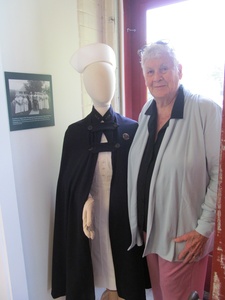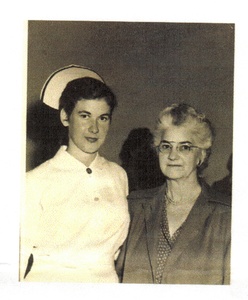 Barbara Skeels McCarthy worked at Trudeau Sanatorium in 1947-1948 as a student nurse. She was a student at Rochester General Hospital. She visited the Saranac Laboratory Museum in 2015 and wrote a letter of her recollections of her time at Trudeau Sanatorium.
Barbara Skeels McCarthy worked at Trudeau Sanatorium in 1947-1948 as a student nurse. She was a student at Rochester General Hospital. She visited the Saranac Laboratory Museum in 2015 and wrote a letter of her recollections of her time at Trudeau Sanatorium.
Barbara Skeels McCarthy's recollections of her time training at Trudeau Sanatorium, as sent in a letter in 2015
As promised, I will attempt to put in writing what I remember about my experience as a student nurse from Rochester General Hospital from December 24, 1947 - February 28, 1948.
When we got off the train and were taxied to Trudeau Sanatorium it was evening and Christmas Eve The setting was so beautiful, the skies so clear and the air a dry cold. I do remember the excitement of being there. The little Red House, the out buildings, and the beautiful Chapel made us feel as though we were in a wonderland of snow. Not a cold, wet, bitter snow, but an Adirondack snow that was both beautiful and a dry cold that Dr. Trudeau discovered to be beneficial to lungs.
When I refer to "we", I believe there were three from RGH; myself, Grace Sterner, Trula Ames and a student, Anita Callahan from Highland Hospital in Rochester, N.Y. The four of us shared a cottage that had cots on an enclosed porch and a sitting room. No kitchen; we ate with the doctors in a rather formal dining room; linen table clothes, silver and waiters. The food was excellent. So far in my search for my Trudeau photos I have come across only one so far. Before I mail this letter to you I hope to find others. This is me in the sitting room knitting, or trying to. Argyle socks were the fad then and I was probably trying to knit a pair then. I was 20 when I arrived and 21 when the train took us to Marcy for our next affiliation.
Back to Trudeau. We started our work training in the infirmary where the sickest patients were. I don't remember it ever being referred to as a hospital but that is essentially what it was. Patients were bedridden and treatments were given there. Pneumothorax, the collapsing of the lung or lobe of a lung was the only surgical procedure I saw, and I believe was the only surgical procedure for patients at that time other than removal of a lung. For that the patient was transferred to the Will Roger's hospital. As students, we spent a day there observing.
I recollect several of the patient's faces but no names other than the ones who signed a card or paper along with a little note when our weeks in the infirmary were over. The only name that tries to make it to my conscious level was, as I recall, Spanish. Juan jumps out. I remember this because he playfully wrote either "I love you" or "Will you marry me?" I kept this moment for many years but over time and many moves it has disappeared. I can guarantee many student nurses received similar notes.
For patients confined to complete bed rest for weeks or months or occasionally a few years, their days were made less dreary if they flirted with the young students who broke up their monotony and isolation. Bedrest 24 hours a day was broken up in the evening by moving the patient onto a porch for the night. The cold night air was thought to be healing. Electric blankets and wool skull caps kept them warm despite the coldest of nights. I do not recall if all patients in the infirmary received this treatment. I doubt it but I have a vivid recollection of pushing beds onto an unheated porch for treatment of night air.
A patient's risk of infecting others was measured by a sputum test; a Gafkey which was measured by a count of 1-10. The spelling may be wrong but phonetically it was gaff-key. Tests were done often. Students were cautioned about eating any of the chocolate candy that were in patient's rooms but when the count was a one or a two temptation often won. Two patients made a huge impression on me. One was a very likable young man, probably 19 or so. He had an infectious toothy smile despite being very ill. He would joke that his lungs were like a golf course, 18 holes. I was told that his parents owned the Grace shipping lines. To have been born with a silver spoon and have so much to live for did not seem right. He was too young and too likable to not get well. I do not know his prognosis but knowing how riddled his lungs were was very sad. I believe that is why he stuck in my memory.
The other patient whom I remember quite well was a lady in a darkened end room. Students did not take care of her. She was accorded the dignity of privacy because of her length of stay. She had been a patient at Trudeau for 20 or 21 years. Television was in its infancy in 1948 but this lady had a TV and this probably accounted for the darkened room. I saw her only a few times and she was always knitting fast and furiously while watching TV. I marveled at how she could knit without looking at her needles. And that is, perhaps why she made such an initial impression on me. It was the Christmas season when I was there and one day she emerged from her room on the arm of two gentlemen as I recall. She was wearing a fur coat and smiling broadly. Very happy. The nurses told me that once a year she was allowed to leave Trudeau to be with family. In retrospect, it was probably an overnight in the local hotel or perhaps just a dinner with family. It was a shock to see this lady walking and obviously so happy after I had been told of her longevity at the Sanitarium. A very few years later after I left, perhaps 1-3 years. Streptomycin was discovered to be a treatment for the tubercular bacillus and this lady was among other patients who were written up in either Life or Look magazine. It told of her story, had pictures of her and she had left the Sanitarium and was living in a cottage in Saranac Lake. The cold air was still considered to be healing. When I visited the Trudeau museum and me you, I had a name to put to the lady with the knitting needles. Isabel. My memory is faulty now and her last name escapes me and I hope you can tell me and give me the name of the two books she wrote. "Smith" and "Bean" come to mind but I am notorious in my 88 years at mangling names.
Patients: Full bed rest no longer needed. These patients were elevated to a new level of care; living in a cottage on the grounds. As students we were assigned to the cottages to check on the patients who could be up and around in their cottage but still needed nursing care. We collected sputum samples, made their beds, gave medicines and that was about it. Kept nurses notes of course. One day the cottage I was assigned to had two young and handsome men in their late teens or early twenties. I was 20. It seemed to me that a little excitement might be what the doctor ordered so when I made their beds I short sheeted them. I was never told of their reaction and was never assigned to them again I can only hope it brought some long, overdue fun into their recovery. The next step after cottages was discharge. Some patients took root in the Village after discharge as did Isabel. Sadly, she passed away in 1958 after describing her remaining years as "having wretched health." She did marry after leaving the San and had some normalcy in her final years.
One of the cottages was a favorite for the young patient. It had some seclusion and an occasional patient would slip into the village in the evening. The old hotel was popular. Dating a patient was strictly taboo but I know of one occasion when a nurse dated a patented while on her two month affiliation and it cost her a lobe of her lung. She contracted the highly infectious disease and ended up with an operation to remove the diseased part of her lung.
This pretty well ends my recollections of Trudeau. Streptomycin brought cures and circa 10 years after I left for the psychiatric hospital in Utica, Trudeau closed as a Sanitarium for the cure of tuberculosis. Going on a tour with you in your museum brought back this flood of memories. Seeing the image of Isabel in her bed at Trudeau was a pleasant shock but also a sad one when I learned o her death 10 years later in 1958. But the memory of her walking out the door to be with family made a huge impression on me. She glowed with happiness. It was difficult not to feel the isolation patients had to endure. If their sputum count was high we had to wear mask, gloves and gown to enter their room. It was difficult not to empathize with the sick and the sicker Streptomycin was the golden bullet for a cure in the late 40s or early 50's. Thank God.
 "Knitting argyle socks," 1948. Historic Saranac Lake Collection. Courtesy of Barbara Skeels McCarthy.
"Knitting argyle socks," 1948. Historic Saranac Lake Collection. Courtesy of Barbara Skeels McCarthy.  "Graduation day with mother," Undated. Historic Saranac Lake Collection. Courtesy of Barbara Skeels McCarthy.
"Graduation day with mother," Undated. Historic Saranac Lake Collection. Courtesy of Barbara Skeels McCarthy.



